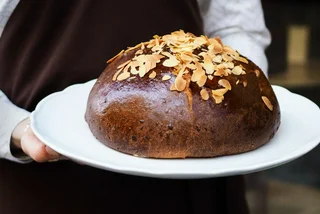When it comes to the classic Czech Easter stuffing, nádivka, most chefs will tell you they stick to the traditional recipe that's been handed down through the family. Some of Prague's top chefs shared with us the tricks, secrets, and essential ingredients for making a stuffing that's the talk of the table. For the most fluffy and beautifully seasoned nádivka, follow the advice of Ambiente chefs.
"Easter stuffing always includes a good houska (a Czech bun), smoked meat, and young nettles, but there are plenty of variations," says Pastacaffé chef Jiří Bergman, who hails from South Bohemia where Easter is elevated to an art form. He says that you can let your imagination run wild when it comes to its variations. "Different recipes are always prepared even between villages that may be only a few kilometers away."
The most important ingredient however is white bread. It's very important to use stale rolls and buns, baguettes, or toasted bread in this recipe. At Prague bakery Eska, a large cube (krychli) of rolled dough is incorporated into the recipe, at Bergman's Pastacaffé they cut light Italian bread into cubes.
chef's tips
- For the best texture, bread cubes should be browned in butter and cooled, ideally overnight to dry out without hardening. Browning brings out the flavor and firms up the crust so that the bread cubes don't get soggy when combined with wet ingredients. The color also makes a lovely pattern when you cut into it.
- Soaking the bread is an important step. Moisten with just a drizzle of milk to avoid a uniform muddy mass with no structure. At Eska, rolls are drizzled with cream; at Pastacaffé they recommend adding stock to the milk to enhance flavor.
- If too much milk or cream soaks into the rolls, very gently squeeze out the excess liquid. Avoid adding flour to a thin mixture, otherwise, you might end up with a stiff dumpling-like filling. You can also sprinkle baking powder or fresh yeast on the moistened bread and the filling will rise nicely.
- The stuffing deserves plenty of fat, especially if you're baking it minus meat. Mix your beat egg yolks and soften butter before adding to the stuffing. The emulsion coats the bread and perfectly binds all the ingredients, which are then salted, peppered, and sprinkled with nutmeg.
- The umami flavor of the smoked meat intensifies the flavor of the stuffing. Ambiente chefs opt for Prague ham, beef fat, bacon, or smoked pork flank, which they pan fry beforehand in sautéed onions. The smoked meat flavor enhances the stuffing and the fat is released in the process. The chefs at Eska also rely on the fat left over from the production of Prague ham cracklings for seasoning.
- A handful of fresh herbs are a must! The Easter version calls for young nettles, which are blanched and finely chopped, or briefly heated in a pan with the roasted smoked meat. You can also pick parsley, lovage, basil, and spinach or bear garlic.
- The stuffing's fluffy consistency is achieved by whipping the egg whites until stiff and then gently folding them into the bread with egg yolks, herbs, and smoked meat. It's key that the stuffing doesn't dry out. A tip: before baking, lay slices of cold herbed butter on top, which will slowly absorb into the bread to create a crispy crust.
Serving suggestions
In the Czech Republic, Easter stuffing is typically served alongside roast chicken or other roasted meat. The stuffing nicely soaks up the juices and adds a green element to the plate. The stuffing can be served on its own (especially the meaty version) or as a side dish instead of potatoes.
Easter nettle stuffing from Eska
Ingredients
- 8 bread rolls or buns
- 200 ml whipped cream
- 8 eggs
- 100 g butter, softened + extra to grease the baking tray
- 400 g young nettles
- 500 g cooked smoked meat, cut into cubes
- 1 onion
- 4 cloves of garlic
- Fresh marjoram, lovage, chives
- 20 g baking powder
- Salt
- Nutmeg
- Black pepper
EGG-STRA TIP: For an extra Easter touch, add a boiled egg to the filling -- it looks beautiful when you ceremoniously slice the stuffing!
Method
- Preheat the oven to 180°C. Grease a baking with butter and set aside.
- Chop the rolls into medium-sized cubes and place them in a bowl. Moisten with a drizzle of cream. In a separate bowl, crack the eggs and separate the yolks from the whites.
- Whisk the egg yolks with the butter and add to the cream-moistened cubes.
- Rinse the nettles thoroughly, briefly scald them with hot water, then immediately rinse with cold water. Chop the drained leaves into smaller pieces and add them to the other ingredients.
- Add smoked meat and finely chopped onion, grated garlic, and chopped herbs to the bread mixture. Sprinkle with baking powder and season with salt, pepper, and nutmeg.
- Beat the egg whites into stiff peaks and mix them with the other ingredients.
- Spread the mixture into the tin and bake for about 40 minutes.
Fun facts about Easter stuffing
- At Lokal Hamburg, almonds are added to the stuffing; they crisp up nicely and add texture.
- First Republic cookbooks devote whole chapters to stuffing and cooking it with liver and veal, crayfish, oysters, raisins, or chestnuts. Other stuffings are flavored with grated or finely chopped lemon rind or even anchovies.
- Easter stuffing is also called "hlavička" (little head), because the original recipes included veal heads. In the Podkrkonoší region, this was the name given to thick, cooled semolina porridge into which eggs, boiled kid offal or meat, and herbs such as parsley, chives nettles were mixed in.
In the Czech Kitchen is a weekly column written in cooperation with the culinary experts from Ambiente. Established in 1995, the Prague-based collective of pubs, restaurants, and fine-dining outlets has transformed the Czech culinary landscape and lent to the widespread awareness of quality food service and production in Czechia. Follow their socials or book your table at www.ambi.cz.












 Reading time: 4 minutes
Reading time: 4 minutes 


















